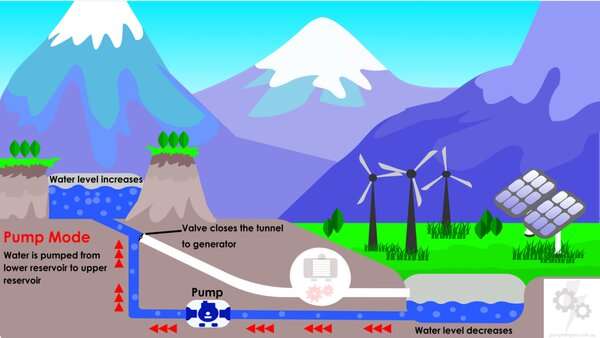
As one of the world’s largest greenhouse gas emitters, Indonesia has pledged to achieve carbon neutrality by 2060.
However, rising living standards, population growth and massive electrification will increase Indonesia’s electricity demand 30-fold, to 9,000 Terawatt-hours (TWh) per year. This rapid increase in electricity consumption raises concerns about energy security and affordability, and environmental sustainability.
Our previous study shows the country could meet its energy needs by relying on its abundant solar energy. By installing billions of solar panels Indonesia could harvest about 190,000 TWh of solar energy per year. This amount of energy is larger than world’s electricity consumption in 2020.
However, relying on solar energy means Indonesia must be able to deal with the risk of shortage because the sun doesn’t shine all the time. To balance a solar-dominated electricity system overnight and during rainy periods, Indonesia will need large amounts of energy storage.
Fortunately, Indonesia has a nature-based solution to this problem: the country can use its enormous potential for off-river pumped hydro energy storage (PHES).
PHES is a technique to store energy by using excess power produced from solar panels during sunny days to pump water uphill to a higher reservoir. When power generation is low during cloudy weather or at night, electricity can then be dispatched on demand from PHES by releasing the stored water downhill to the lower reservoir through the turbine.
In our latest study, we have identified that excellent sites for PHES reservoirs are available all over the country, including the heavily populated islands of Java, Bali and Sumatra.
Off-river PHES for energy balancing
To develop an off-river PHES, we need two closely spaced lakes or reservoirs of about one square kilometers each that have an altitude difference of about 600 meters. They are connected by a tunnel containing a pump-turbine.
Unlike conventional (river-based) PHES, we don’t need to build dams on rivers because the water flows through tunnels connecting two reservoirs. We can also use old mining sites, as well as existing lakes and reservoirs. This means off-river PHES systems can have low environmental and social impacts.
The area of land required for an off-river PHES is also relatively small. A typical 150 gigawatt-hour (GWh) off-river pumped hydro requires about 8 hectares of land per GWh. In comparison, the river-based Upper Cisokan PHES project in West Java with 7 GWh of storage requires a flooded area of 340ha (50ha per GWh).
With a lifespan of 50–100 years, off-river PHES systems also could reduce our dependency on conventional batteries, which typically have a storage lifetime of 10–15 years. Batteries also contain materials that are in short supply such as lithium and cobalt.
How large is the potential?
Indonesia has 26,000 potential pumped hydro sites, which is far more than needed. We narrowed it down by choosing the best possible resources all over the country with the highest storage quality and the lowest cost with potential of 321 TWh.
Eastern Indonesian regions (Sulawesi, Maluku Papua, and Kalimantan) have the most potential, with low storage requirements. This contrasts with the western Indonesia region (Java and Sumatra), which is expected to have substantial future storage demands.
The following figure illustrates the size of best PHES potential in each Indonesian region compared with the requirements in 2060 for an affluent, decarbonized Indonesia.
In our future work, we will examine whether Indonesia needs to build strong electricity transmission links from east to west for a low-cost power grid or whether the system is better operated independently in each region.
Off-river PHES is affordable
Pumped hydro storage is by far the cheapest way of storing solar energy overnight, and has by far the largest share of the global energy storage market.
In our recent paper, we modeled a hypothetical 150 GWh site in Wonosobo Regency in Central Java with power capacity of 7.5 gigawatts—which is a large storage system. This system could run at full generating power for 20 hours. The site has a height difference between the reservoirs of 741 meters, a tunnel length of 4km and requires 4ha of flooded land per GWh.
We estimated a capital cost of US$9.4 billion to develop this site, including the cost of the initial water filling and land acquisition. For comparison, a Tesla utility-scale battery pack will require a capital cost of US$60 billion for the same capacity (150 GWh)—US$1.2 million per 3 MWh.
By knowing Indonesia’s off-river PHES potential, the government could plan to develop very large-scale solar generation with confidence. Thus, an energy transition towards carbon neutrality is a realistic target to achieve.
This article is republished from The Conversation under a Creative Commons license. Read the original article.
Citation:
Indonesia could pair its vast solar and hydro storage to decarbonize the country (2022, May 26)
retrieved 26 May 2022
from https://techxplore.com/news/2022-05-indonesia-pair-vast-solar-hydro.html
This document is subject to copyright. Apart from any fair dealing for the purpose of private study or research, no
part may be reproduced without the written permission. The content is provided for information purposes only.
For all the latest Technology News Click Here
For the latest news and updates, follow us on Google News.

